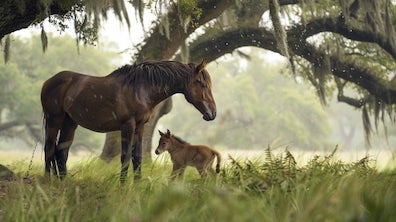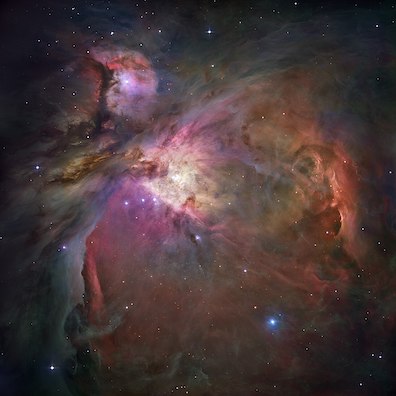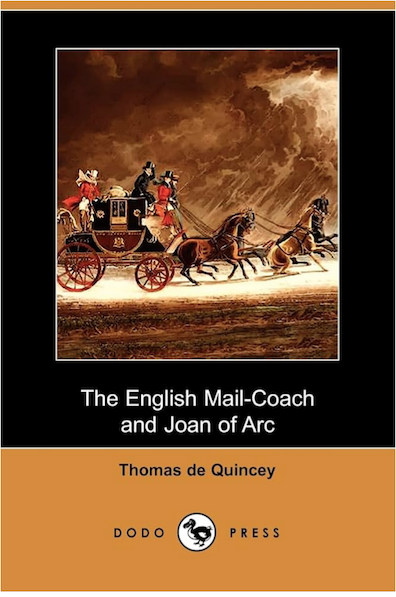In the previous section Bloom became lost in thought as he
pondered earlier episodes in his life. Now the voices around
him recede further into a "silence that is the infinite of
space," and "the soul is wafted over regions of
cycles of generations that have lived." The
preoccupation with infinities of space and time comes directly
from De Quincey's works, and so does the genre of the
dream-vision. This one unfolds in three parts. First the soul
finds itself in a timeless blurry pastureland where "grey
twilight ever descends, never falls," and there two ghostly
but graceful horses walk, "a mare leading her fillyfoal."
"They fade, sad phantoms," and are replaced by a varied parade
of ghostly animals, all tramping through a sandy wasteland to
drink the undrinkable waters of the Dead Sea and portending
violence: "muttering thunder of rebellion," "murderers of the
sun," "Ominous revengeful zodiacal host!" Then the peaceful
vision returns, but now radically changed. Where once two
horses stood under "a perennial dew of stars," now an "equine
portent" fills "the deserted heavens" like some vast
constellation or nebula, floating, gleaming, swirling,
metamorphosing until "it blazes, Alpha, a ruby and triangled
sign upon the forehead of Taurus."
The visionary particulars seem obscure, but these apparitions
all clearly evoke aspects of Bloom's consciousness. The two
horses are mother and daughter, and when a female presence
returns in the third section it carries overtones of both
Molly and Milly. The shift from pastoral beauty to Palestinian
desolation recalls the moment in Calypso when a cloud
covered the sun, dampening Bloom's thoughts of an idyllic Agendath
Netaim: "No, not like that. A barren land, bare waste.
Vulcanic lake, the dead sea: no fish, weedless,
sunk deep in the earth. No wind would lift those waves, grey
metal, poisonous foggy waters." In Oxen the thought
that "Agendath is a waste land...Netaim, the golden, is no
more" banishes the vision of female beauty, much as Bloom's
thoughts of the Dead Sea in Calypso led to thoughts of
sexual barrenness: "Dead: an old woman's: the grey sunken cunt
of the world." It is surely no accident that the
dream-vision language in Oxen recalls one of Bloom's
most dreamlike, visionary moments in the novel.
When female beauty returns in the third section, it has moved
into Bloom's cherished field of astronomy, and its
semicelestial quality recalls his meditations on beautiful but
asexual nymphs and goddesses. The apparition looms "over the
house of Virgo," Molly's zodiacal sign, but in it virginity
trumps wifehood: "the everlasting bride, harbinger of the
daystar, the bride, ever virgin." Bloom's daughter Milly, who
has recently left home and who he fears may have become
sexually active, also hovers here preserved in a pure state: "thou lost
one, Millicent, the young, the dear, the radiant." (The
beckoning "Martha"
Clifford, with whom Bloom has no intention of beginning a
sexual relationship, may also be here.)
These intimate relationships carry intense sexual
associations for Bloom, but they have become sublimated in a
vision of angelic, ephemeral splendor: "How serene does she
now arise, a queen among the Pleiades, in the penultimate
antelucan hour, shod in sandals of bright gold, coifed
with a veil of what do you call it gossamer. It floats, it
flows about her starborn flesh and loose it streams, emerald,
sapphire, mauve and heliotrope, sustained on currents of
cold interstellar wind." Here once again the passage in
Calypso is echoed. When the sun reappeared there,
Bloom's thoughts moved from old barren women to young vital
girls: "Quick warm sunlight came running from Berkeley road, swiftly,
in slim sandals, along the brightening footpath. Runs,
she runs to meet me, a girl with gold hair on the
wind."
The visionary details recall things that Bloom has thought
and felt earlier in the day, but the final image brings
readers back to the concrete scene in the hospital common
room. Not that they could possibly draw such an inference from
"a ruby and triangled sign upon the forehead of
Taurus." Joyce waits until the end of the following long
paragraph to feed them a clue, in the form of one of Lenehan's
puns: "If I had poor luck with Bass's mare perhaps this
draught of his may serve me more propensely." The
antiquated prose identifies "this draught" as "a winejar," but
in fact it is a bottle of Bass ale with its recognizable red
triangle: "Malachi saw it and withheld his act, pointing to
the stranger and to the scarlet label. Warily, Malachi
whispered, preserve a druid silence. His soul is far away. It
is as painful perhaps to be awakened from a vision as to be
born. Any object, intensely regarded, may be a gate of access
to the incorruptible eon of the gods." The previous section's
De Quinceyan venture into wafting souls, dream visions, and
incorruptible eons resolves, then, in a bathetic detail. Bloom
has become lost in thought while gazing at a beer bottle.
Joyce's parody captures the quality of what De Quincey called
his "impassioned prose," and it borrows one or two words from
Opium-Eater, but it does not sound much like any
section of that work. In his study of the sources of Oxen's
styles, however, Robert Janusko suggests a debt to The
English Mail-Coach (1849). Section 3 of that work, a
series of opium-like reveries titled "Dream Fugue," tells a
very different story from Joyce's parody, but it contains what
Janusko calls a "similar sequence of images" (72-73). All of
them are hallucinatory responses to the fear of mortality
raised in section 2, "The Vision of Sudden Death," where De
Quincey recounts a near-accident between a massive mail-coach
and a small carriage holding a young couple.
At a time of "morning twilight" when things are "almost
hidden in mist" and sights are "dusky," De Quincey, sleeping
on a boat "moored to some familiar shore," is roused by the
sound of "Sweet funeral bells from some incalculable
distance." He sees a girl adorned with white roses on her head
running along the beach in terror, as if chased by something
horrible. Concerned, he follows her and arrives in time to see
her swallowed by quicksand. He sits and weeps for her
"blighted dawn." Key elements of this story of a girl
tragically swallowed by death carry over into Joyce's parody:
sounds heard across vast distances (Joyce paradoxically
contrives to have the voices in the common room "blend and
fuse in clouded silence: silence that is the infinite of
space"), forms veiled by misty half-light (the words
"twilight" and "dusk" both carry over into Oxen), a
beautiful girl (Joyce creates two figures, mother and
daughter), and death (Joyce says only that the phantom horses
are "sad," and "fade," and are "gone").
De Quincey's scene then erupts in sound: "But suddenly the
tears and funeral bells were hushed by a shout as of many
nations, and by a roar as from some great king's artillery,
advancing rapidly along the valleys, and heard afar by echoes
from the mountains. 'Hush!' I said, as I bent my ear
earthwards to listen—'hush!'" Either the sounds are "the very
anarchy of strife," the dreamer thinks, or "it is victory that
is final, victory that swallows up all strife'." The thought
proves prophetic: in a trance he is carried to "some distant
kingdom, and placed upon a triumphal car" with some
companions, tasked with publishing joyful ecclesiastical
"Tidings" throughout the land. This extended phantasmagoric
travelogue is filled with loud sounds: choirs, orchestras,
chanting, horses' "thunderings," "snortings and tramplings,"
blasts of a trumpet. Joyce's sentences do not reproduce any of
this story, but he may be responding to its auditory details.
His animals create a "muttering thunder," and the trumpet
blasts perhaps linger in his "trumpeted" elephants, mammoths,
and mastodons. The cries of "Hush!...Hush!" resemble "Huuh!
Hark! Huuh!," Joyce's recollection of the drover who
goaded cattle through the streets in Hades:
"Huuuh!...Huuuh! out of that!" The "snortings and tramplings"
of horses find an echo in Joyce's beasts who "tramp" to the
water, "moaning."
At the end of De Quincey's vision people clamor to know, "is
the young child caught up to God?" The answer appears in a
vision of a marble altar above three tall windows in the
clouds. The red light of dawn is streaming through the
windows, brightening the red robes of martyrs depicted
on them, and "There, suddenly, within that crimson radiance,
rose the apparition of a woman's head, and then of a woman's
figure. The child it was—grown up to woman's height. Clinging
to the horns of the altar, voiceless she stood—sinking,
rising, raving, despairing." Some demonic presence wants her
dead, but a "better angel" successfully pleads for her
deliverance. Joyce's dream-vision imitates this part of De
Quincey's rather closely: "Millicent, the young, the dear, the
radiant. How serene does she now arise, a queen among the
Pleiades." The kinetic quality of De Quincey's female
apparition ("sinking, rising, raving, despairing") is repeated
in Joyce's: "It floats, it flows," "winding, coiling, simply
swirling, writhing."
If Joyce did have this part of The English Mail-Coach
in mind as he wrote, he did not care to reproduce its
Christian theme of God rescuing humanity from the clutches of
death. Instead, his visions trace the outlines of Bloom's
sexual anxiety. The beautiful phantom horses, which hover and
disappear, suggest Bloom's fear of losing his beloved wife and
daughter. The cacophonous counter-vision brings back his
nightmarish apprehension in Calypso that the promised
land may be a desert, his marriage barren, his youthful
vitality lost forever. And the return of the "equine portent"
seems to promise some kind of transcendental release from
these existential terrors. Floating in the heavens, immune to
the destructive effect of sexual passion, Molly is an
"everlasting bride" who is "ever virgin," and Milly is a
youthful but regal goddess, not a pretty girl venturing
perilously far from home.





